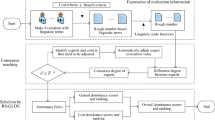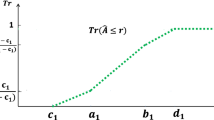Abstract
In recent years, Reverse Logistics (RL) has been touted as one of the strategies of improving organization performance and generating a competitive advantage. In RL, the generic routing problem has become a focus since it provides a great flexibility in modeling, e.g., selection of suppliers by using a node as a supplier candidate in a network. To date, complicated networks make decision makers hard to search a desired routine. In addition, the traditional network defines and resolves such a problem only at one soot. The solution cannot be acquired from multiple perspectives like minimal cost, minimal delivery time, maximal reliability, and optimal “3Rs”—reduce, reuse, and recycle. In this study, rough set theory is applied to reduce complexity of the RL data sets and induct decision rules. Through incorporating the decision rules, the generic label correcting algorithm is used to solve generic routing problems by integrating various operators and comparators in the GLC algorithm. Consequently, the desired RL suppliers are selected.











Similar content being viewed by others
References
Alshamrani, A., Mathur, K., & Ballou, R. H. (2007). Reverse logistics: simultaneous design of delivery routes and returns strategies. Computers & Operations Research, 34, 595–619.
Chan, F. T. S., Chan, H. K., & Zhang, J. (2006). Reverse logistics model for mobile phone industry. Service operations and logistics, and informatics, 2006. SOLI ’06. IEEE international conference on, 21–23, 2006, pp 294–299.
Chuang, P. T. (2002). A QFD approach for distribution’s location model. International Journal of Quality and Reliability Management, 19, 1037–1054.
Cho, D. W., Lee, Y. H., Lee, T. Y., & Gen, M. (2013). An adaptive genetic algorithm for the time dependent inventory routing problem. Journal of Intelligent Manufacturing, 24(1), 1–18.
Ding, Z., Zhu, X., Zhao, J., & Xu, H. (2008). New knowledge acquisition method in incomplete information system based on rough set and self-adaptive genetic algorithm. In Granular computing, 2008. GrC 2008. IEEE international conference on, 26–28, 2008, pp. 196–200.
Efendigil, T., Önüt, S., & Kongar, E. (2008). A holistic approach for selecting a third-party reverse logistics provider in the presence of vagueness. Computers & Industrial Engineering, 54, 269–287.
Fan, Z. G., & Lu, B. L. (2005). Fast recognition of multi-view faces with feature selection. Computer vision, 2005. ICCV 2005. Tenth IEEE international conference on, 1, 2005, pp. 76–81.
Goncalves, G., Hsu, T., & Xu, J. (2009). Vehicle routing problem with time windows and fuzzy demands: An approach based on the possibility theory. International Journal of Advanced Operations Management, 1, 312–330.
Gong, Z. T., Sun, B. Z., Xu, Z. M., & Zhang, Z. Q. (2006). The rough set analysis approach to water resources allocation decision in the Inland River Basin of Arid Regions (II): The conflict analysis of satisfactions of the decision. Machine learning and cybernetics, 2006 international conference on, 13–16, 2006, pp. 1358–1361.
Grenchus, E., Johnson, S., & McDonnell, D. (2001). Improving environmental performance through reverse logistics at IBM(R). Electronics and the environment, 2001. Proceedings of the 2001 IEEE international symposium on, 7–9, 2001, pp. 236–240.
Guo, Q., & Li, C. (2007). Research on data mining based on rough set and its application in fault diagnosis of steam turbine. Fuzzy systems and knowledge discovery, 2007. FSKD 2007. Fourth international conference on, 3, 2007, pp. 188–192.
Heckerman, D., Mannila, H., Pregibon, D., & Uthurusamy R. (1997). In Proceedings of the third international conference on knowledge discovery and data mining. Menlo Park, CA: AAAI Press.
Hua, J. (2008). Study on the application of rough sets theory in machine learning. Intelligent information technology application, 2008. IITA ’08. Second international symposium on, 1, 2008, pp. 192–196.
Huang, C. C., Liang, W. Y., & Lin, S. H. (2009). An agile approach for supply chain modeling. Transportation Research Part E: Logistics and Transportation Review, 45, 380–397.
Huang, K., & Aviyente, S. (2008). Wavelet feature selection for image classification. IEEE Transactions on Image Processing, 17, 1709–1720.
Kothari, A., Keskar, A., Gokhale, A., Deshpande, R., & Deshmukh, P. (2008). Rough set approach for feature reduction in pattern recognition through unsupervised artificial neural network. Emerging trends in engineering and technology, 2008. ICETET ’08. First international conference on, 16–18, 2008, pp. 1196–1199.
Kusiak, A. (2001). Rough set theory: A data mining tool for semiconductor manufacturing. IEEE Transactions lectronics Packaging Manufacturing, 24, 44–50.
Kim, B. I., & Son, S. J. (2012). A probability matrix based particle swarm optimization for the capacitated vehicle routing problem. Journal of Intelligent Manufacturing, 23(4), 1119–1126.
Lambert, S., & Riopel, D. (2003). Logistique inverse: revue de littérature. Les Cahiers du GERAD G, 61, 45.
Laporte, G. (2007). What you should know about the vehicle routing problem. Naval Research Logistics, 54, 811–819.
Li, J. R., Khoo, L. P., & Tor, S. B. (2006). RMINE: A rough set based data mining prototype for the reasoning of incomplete data in condition-based fault diagnosis. Journal of Intelligent Manufacturing, 17(1), 163–176.
Pawlak, Z. (1982). Rough sets. International Journal of Computer and Information Sciences, 11, 341–356.
Petrosino, A., & Salvi, G. (2006). Rough fuzzy set based scale space transforms and their use in image analysis. International Journal of Approximate Reasoning, 41(2), 212–228.
Rogers, S., & Tibben-Lembke, R. S. (1999). Going backwards: Reverse logistics trends and practices. Pittsburgh: RLEC Press.
Srivastava, S. K. (2008). Network design for reverse logistics. Omega, 36, 535–548.
Tseng, T. L., & Huang, C. C. (2005). Rough set based approach to feature selection in customer relationship management. The International Journal of Management Science, OMEGA journal, 35, 365–383.
Tzeng, G. H., Teng, M. H., Chen, J. J., & Opricovic, S. (2002). Multicriteria selection for a restaurant location in Taipei. Hospitality Management, 21, 171–187.
Wang, Q. H., & Li, J. R. (2004). A rough set-based fault ranking prototype system for fault diagnosis. Engineering Applications of Artificial Intelligence, 17, 909–917.
Wang, Y. (2008). Time series mining technique based on varying series and rough set approach. Intelligent control and automation, 2008. WCICA 2008. 7th world congress on, 25–27, 2008, pp. 141–145.
Yang, J., Golany, B., & Yu, G. (2005). A concave-cost production planning problem with remanufacturing options. Naval Research Logistics, 52, 443–458.
Yoshida, H., Shimamura, K., & Aizawa, H. (2007). 3R strategies for the establishment of an international sound material-cycle society. Material Cycles and Waste Management, 9, 101–111.
Zhai, J., Xu, X., Xie, C., & Luo, M. (2004). Fuzzy control for manufacturing quality based on variable precision rough set. Intelligent Control and Automation, 3, 2347–2351.
Zhang, C., Chang, G., Fan, Y., & Yu, H. (2006). Coordination strategy for production planning in supply chain based on Lagrange relaxation slgorithm. 2006 IEEE Asia-Pacific conference on services, computing (APSCC’06) (2006), pp. 613–616.
Zheng, Y., & Zhang, G. (2008). A genetic algorithm for vehicle routing problem with forward and reverse logistics. Wireless communications, networking and mobile computing, 2008. WiCOM ’08. 4th international conference on, 12–14, 1–4.
Zhang, X. H., Deng, Z. H., Liu, W., & Cao, H. (2013). Combining rough set and case based reasoning for process conditions selection in camshaft grinding. Journal of Intelligent Manufacturing, 24(2), 211–224.
Acknowledgments
This research has been partially supported by funds from the National Science Counsel (Grant No. 98-2410-H-260-011-MY3; 99-2410-H-018-016-MY3).
Author information
Authors and Affiliations
Corresponding author
Rights and permissions
About this article
Cite this article
Huang, CC., Liang, WY., Tseng, TL. et al. The rough set based approach to generic routing problems: case of reverse logistics supplier selection. J Intell Manuf 27, 781–795 (2016). https://doi.org/10.1007/s10845-014-0913-8
Received:
Accepted:
Published:
Issue Date:
DOI: https://doi.org/10.1007/s10845-014-0913-8




